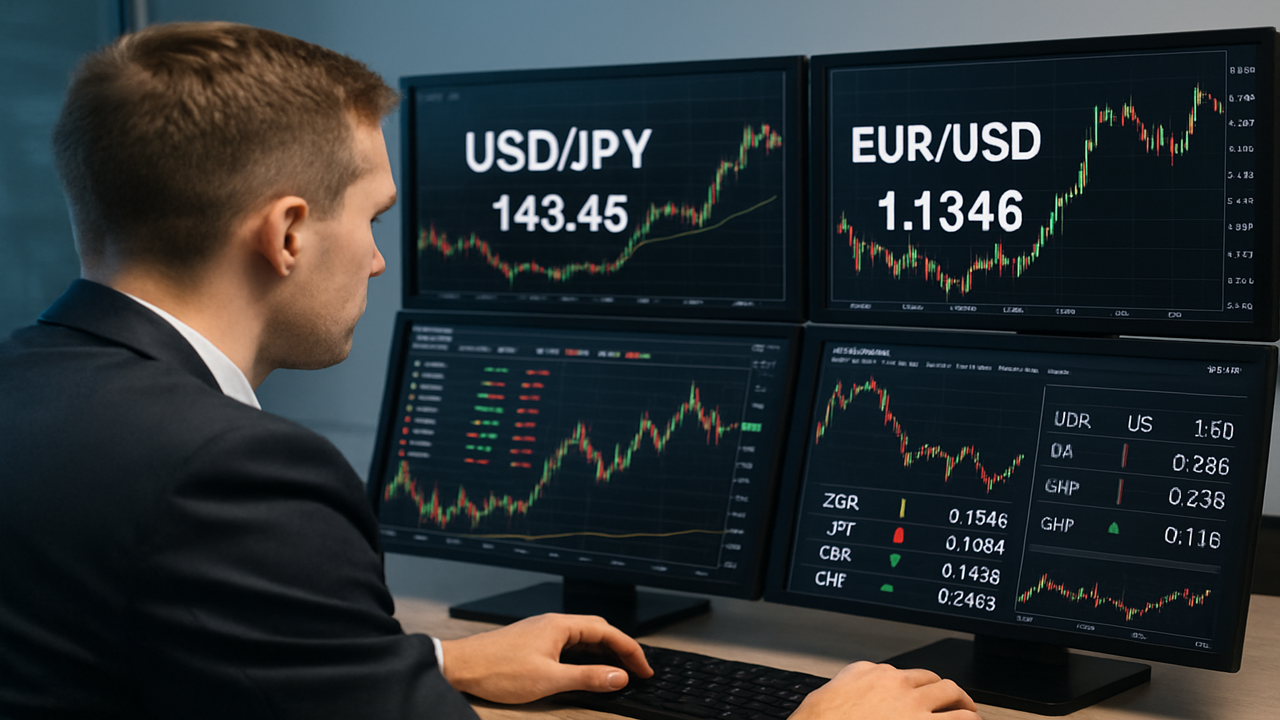The U.S. dollar held steady at the start of the week as investors treaded cautiously, awaiting a wave of economic data that could offer fresh insight into whether the Trump administration’s ongoing trade conflict is beginning to weigh on the American economy.
Despite lingering volatility in global markets, the greenback managed to recover some ground, trading slightly stronger against the euro at $1.1346 and mostly flat against the yen at 143.45.

Still, the dollar remains on track for its largest monthly decline in over two and a half years, a sign of the underlying anxiety that has gripped markets amid unpredictable trade policy developments. At the heart of this uncertainty is the Trump administration’s tariff strategy, which has injected fresh turbulence into U.S.
-China relations. President Donald Trump has repeatedly claimed progress in negotiations and insisted he has spoken with Chinese President Xi Jinping. Yet Beijing has pushed back on these assertions, denying that any formal trade talks are taking place.
Adding to the confusion, U.S. Treasury Secretary Scott Bessent, when pressed on the issue, stopped short of confirming that tariff discussions are underway.
This geopolitical tension has left currency traders and economists focused on the potential real-world fallout, particularly in the labor market. April’s U.S.
jobs report, set for release on Friday, is expected to reveal whether hiring momentum is beginning to stall as companies navigate the murky waters of trade uncertainty. Chris Turner, global head of markets at ING, summed up the mood by noting, “The next big chapter here will be whether all this volatility has hit real-world decisions, especially in the U.S.
jobs market.” Forecasters still expect job growth for the month, though at a slower pace than in recent periods. A significant disappointment in the labor numbers could intensify speculation about a possible Federal Reserve rate cut.
However, so far, Fed Chair Jerome Powell and other central bank officials have signaled patience, suggesting they are unwilling to respond to political noise alone without hard evidence of economic deterioration. Charu Chanana, chief investment strategist at Saxo Bank, echoed this sentiment, explaining that while tariffs raise the odds of eventual Fed action, the response may come more slowly than markets anticipate. “They need real deterioration to justify a move, not just forecasts or soft indicators,” she said, adding that the Fed is likely to hold off unless jobs data and consumer spending show clear signs of strain.
Beyond the jobs report, investors are also eyeing first-quarter U.S. gross domestic product (GDP) figures and the Federal Reserve’s preferred inflation gauge, the core personal consumption expenditures (PCE) index, both of which are scheduled for release this week.
Together, these reports will help shape expectations about the economy’s resilience in the face of global trade disruptions. Across the Atlantic, the euro held steady against other major currencies such as the British pound, even as parts of Spain were hit by a large-scale power outage. In Canada, the national currency remained stable ahead of federal elections, with market participants not expecting significant swings regardless of the outcome.
Options trading pointed to limited expectations for volatility, and the Canadian dollar hovered at C$1.3873 per U.S.
dollar. In Japan, attention turned to the Bank of Japan’s upcoming policy decision, expected on Thursday. While no immediate changes to monetary policy are anticipated, investors remain alert to how Japanese policymakers will navigate the current global economic uncertainty, especially given that U.
S.-Japan trade talks are likely to touch on currency issues. Japan’s top currency diplomat, Atsushi Mimura, sought to quash rumors sparked by a Yomiuri newspaper report suggesting that Treasury Secretary Bessent had voiced support for a weaker dollar and stronger yen during bilateral meetings.
As the week progresses, financial markets remain locked in a holding pattern, weighing political developments against the upcoming tide of economic data. With so much riding on these reports, the trajectory of the U.S.
dollar—and by extension, broader market sentiment—now hinges less on policy rhetoric and more on whether the hard numbers reflect a system under genuine strain..
Dollar Steadies as Investors Eye Tariffs, Jobs Data, and Fed Signals

Dollar Steadies as Investors Eye Tariffs, Jobs Data, and Fed Signals The U.S. dollar held steady at the start of the week as investors treaded cautiously, awaiting a wave of economic data that could offer fresh insight into whether the Trump administration's ongoing trade conflict is beginning to weigh on the American economy. Despite lingering volatility in global markets, the greenback managed to recover some ground, trading slightly stronger against the euro at $1.1346 and mostly flat against the yen at 143.45. Still, the dollar remains on track for its largest monthly decline in over two and a half years, a sign of the underlying anxiety that has gripped markets amid unpredictable trade policy developments.At the heart of this uncertainty is the Trump administration's tariff strategy, which has injected fresh turbulence into U.S.-China relations. President Donald Trump has repeatedly claimed progress in negotiations and insisted he has spoken with Chinese President Xi Jinping. Yet Beijing has pushed back on these assertions, denying that any formal trade talks are taking place. Adding to the confusion, U.S. Treasury Secretary Scott Bessent, when pressed on the issue, stopped short of confirming that tariff discussions are underway.This geopolitical tension has left currency traders and economists focused on the potential real-world fallout, particularly in the labor market. April's U.S. jobs report, set for release on Friday, is expected to reveal whether hiring momentum is beginning to stall as companies navigate the murky waters of trade uncertainty. Chris Turner, global head of markets at ING, summed up the mood by noting, "The next big chapter here will be whether all this volatility has hit real-world decisions, especially in the U.S. jobs market."Forecasters still expect job growth for the month, though at a slower pace than in recent periods. A significant disappointment in the labor numbers could intensify speculation about a possible Federal Reserve rate cut. However, so far, Fed Chair Jerome Powell and other central bank officials have signaled patience, suggesting they are unwilling to respond to political noise alone without hard evidence of economic deterioration.Charu Chanana, chief investment strategist at Saxo Bank, echoed this sentiment, explaining that while tariffs raise the odds of eventual Fed action, the response may come more slowly than markets anticipate. "They need real deterioration to justify a move, not just forecasts or soft indicators," she said, adding that the Fed is likely to hold off unless jobs data and consumer spending show clear signs of strain.Beyond the jobs report, investors are also eyeing first-quarter U.S. gross domestic product (GDP) figures and the Federal Reserve's preferred inflation gauge, the core personal consumption expenditures (PCE) index, both of which are scheduled for release this week. Together, these reports will help shape expectations about the economy's resilience in the face of global trade disruptions.Across the Atlantic, the euro held steady against other major currencies such as the British pound, even as parts of Spain were hit by a large-scale power outage. In Canada, the national currency remained stable ahead of federal elections, with market participants not expecting significant swings regardless of the outcome. Options trading pointed to limited expectations for volatility, and the Canadian dollar hovered at C$1.3873 per U.S. dollar.In Japan, attention turned to the Bank of Japan's upcoming policy decision, expected on Thursday. While no immediate changes to monetary policy are anticipated, investors remain alert to how Japanese policymakers will navigate the current global economic uncertainty, especially given that U.S.-Japan trade talks are likely to touch on currency issues. Japan's top currency diplomat, Atsushi Mimura, sought to quash rumors sparked by a Yomiuri newspaper report suggesting that Treasury Secretary Bessent had voiced support for a weaker dollar and stronger yen during bilateral meetings.As the week progresses, financial markets remain locked in a holding pattern, weighing political developments against the upcoming tide of economic data. With so much riding on these reports, the trajectory of the U.S. dollar—and by extension, broader market sentiment—now hinges less on policy rhetoric and more on whether the hard numbers reflect a system under genuine strain.











